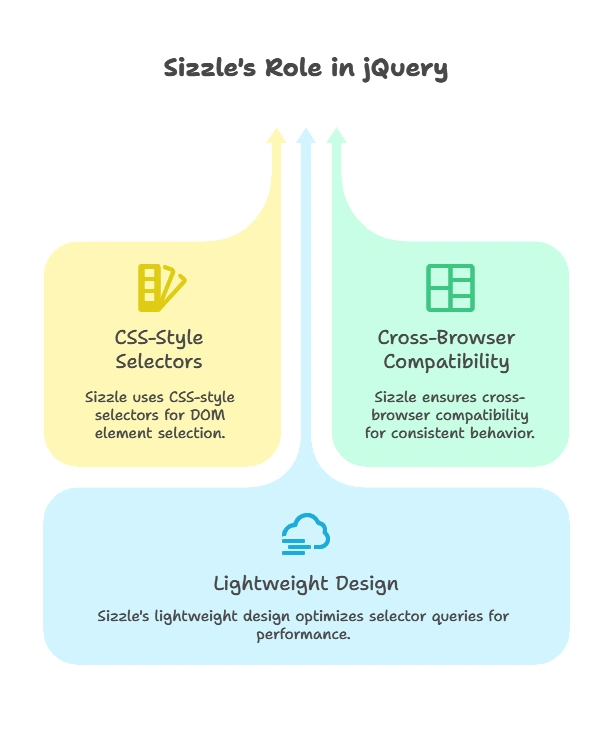What is JQuery ?
jQuery is a JavaScript library that simplifies HTML document traversing, event handling, animating, and AJAX interactions for rapid web development. It provides a simple yet powerful API for manipulating HTML elements and handling events, making it easier to create dynamic and interactive web pages.
Jquery Engine Sizzle
jQuery primarily uses Sizzle as its selector engine. Sizzle is a standalone library within jQuery that handles the selection of elements from the DOM using CSS-style selectors. It’s responsible for parsing and interpreting selectors efficiently, allowing jQuery to target and manipulate DOM elements effectively across different browsers.
Sizzle is designed to be lightweight and fast, optimizing selector queries for performance while maintaining cross-browser compatibility. It abstracts away the complexities of browser-specific quirks and differences, ensuring consistent behavior across various environments.
By utilizing Sizzle as its selector engine, jQuery can provide developers with a familiar and intuitive API for DOM manipulation, event handling, and other tasks, while also delivering efficient and reliable performance across different browsers and platforms.

Why use jQuery?
- Cross-browser compatibility: jQuery abstracts away browser differences, allowing developers to write code that works consistently across various browsers.
- Simplicity and productivity: jQuery simplifies complex JavaScript tasks with its concise syntax and powerful methods, enabling developers to accomplish more with less code.
- Large community and ecosystem: jQuery has a vast community of developers and a rich ecosystem of plugins and extensions, making it easy to find solutions to common problems and extend its functionality.
History of jQuery
Release: jQuery was created by John Resig and released in 2006.
Rapid Adoption: Due to its simplicity and effectiveness, jQuery quickly gained popularity among web developers and became one of the most widely used JavaScript libraries.
Version Updates: jQuery has gone through several version updates, each introducing new features, performance improvements, and bug fixes to meet the evolving needs of web development.
Uses of jQuery
DOM Manipulation: jQuery simplifies traversing and manipulating the HTML DOM, allowing developers to easily select, modify, create, and remove elements on web pages.
Event Handling: jQuery provides an elegant way to handle user interactions and events such as clicks, mouse movements, keyboard inputs, etc., making web pages more interactive and responsive.
AJAX Interactions: With jQuery, making asynchronous HTTP requests becomes straightforward, enabling developers to fetch data from a server and update parts of a web page without reloading the entire page.
Animation and Effects: jQuery simplifies the creation of animations and effects, adding visual appeal to web pages through smooth transitions, fades, slides, and more.
Cross-browser Compatibility: jQuery abstracts away browser inconsistencies, ensuring that code works consistently across different browsers, thus saving developers time and effort in handling browser-specific quirks.
Advantages of jQuery
Simplicity: jQuery simplifies complex JavaScript tasks with its concise syntax and intuitive API, making it easier for developers to write code and accomplish tasks more efficiently.
Cross-browser Compatibility: jQuery abstracts away browser differences, providing a consistent API that works seamlessly across various browsers, thus saving developers from dealing with browser-specific quirks.
Rich Ecosystem: jQuery has a vast ecosystem of plugins and extensions, offering a wide range of pre-built solutions for common tasks, such as sliders, form validation, and UI widgets, which can significantly accelerate development.
Community Support: jQuery has a large and active community of developers who contribute plugins, provide support, and share knowledge, making it easy to find solutions to problems and stay updated with best practices.
Performance: jQuery is lightweight and optimized for performance, ensuring fast execution and minimal overhead, which is crucial for delivering responsive and high-performance web applications
Disadvantages of jQuery
Overhead: Including the jQuery library adds extra overhead to web pages, which may impact performance, especially on mobile devices with limited resources or slow network connections.
Learning Curve: While jQuery simplifies many aspects of JavaScript development, there is still a learning curve for beginners to understand its API and use it effectively, especially when dealing with more advanced features.
Dependency: Relying heavily on jQuery for DOM manipulation and event handling may lead to a dependency on the library, making it challenging to migrate to newer technologies or frameworks in the future.
Performance Overhead: In some cases, using jQuery for simple tasks may introduce unnecessary performance overhead compared to vanilla JavaScript solutions, especially when dealing with modern browser APIs and features.
Maintainability: As web development evolves, maintaining legacy code written with jQuery may become challenging, especially when dealing with large codebases or projects that span multiple years, requiring continuous updates and refactoring.
JQuery remains a valuable tool for web developers, offering simplicity, cross-browser compatibility, and a rich ecosystem of plugins. However, it's essential to weigh its pros and cons carefully and use it judiciously based on the specific requirements and constraints of each project. Additionally, staying updated with modern JavaScript features and frameworks can help mitigate some of the limitations associated with jQuery.Happy coding ! ❤️
